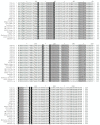Molecular Characteristics of Bovine Viral Diarrhea Virus Strains Isolated from Persistently Infected Cattle
- PMID: 37505819
- PMCID: PMC10384089
- DOI: 10.3390/vetsci10070413
Molecular Characteristics of Bovine Viral Diarrhea Virus Strains Isolated from Persistently Infected Cattle
Abstract
In this study, we reported the isolation, identification, and molecular characteristics of nine BVDV strains that were isolated from the serum of persistently infected cattle. The new strains were designated as BVDV TJ2101, TJ2102, TJ2103, TJ2104, TJ2105, TJ2106, TJ2107, TJ2108 and TJ2109. The TJ2102 and TJ2104 strains were found to be cytopathic BVDV, and the other strains were non-cytopathic BVDV. An alignment and phylogenetic analysis showed that the new isolates share 92.2-96.3% homology with the CP7 strain and, thus, were classified as the BVDV-1b subgenotype. A recombination analysis of the genome sequences showed that the new strains could be recombined by the major parent BVDV-1a NADL strain and the minor parent BVDV-1m SD-15 strain. Some genome variations or unique amino acid mutations were found in 5'-UTR, E0 and E2 of these new isolates. In addition, a potential linear B cell epitopes prediction showed that the potential linear B cell epitope at positions 56-61 is highly variable in BVDV-1b. In conclusion, the present study has identified nine strains of BVDV from persistently infected cattle in China. Further studies on the virulence and pathogenesis of these new strains are recommended.
Keywords: BVDV-1b; bovine viral diarrhea virus; molecular characteristics; persistently infected cattle.
Conflict of interest statement
The authors declare no conflict of interest.
Figures









Similar articles
-
Isolation of BVDV-1a, 1m, and 1v strains from diarrheal calf in china and identification of its genome sequence and cattle virulence.Front Vet Sci. 2022 Nov 16;9:1008107. doi: 10.3389/fvets.2022.1008107. eCollection 2022. Front Vet Sci. 2022. PMID: 36467650 Free PMC article.
-
Molecular Characterization of a Novel Bovine Viral Diarrhea Virus Isolate SD-15.PLoS One. 2016 Oct 20;11(10):e0165044. doi: 10.1371/journal.pone.0165044. eCollection 2016. PLoS One. 2016. PMID: 27764206 Free PMC article.
-
A bovine viral diarrhea virus type 1a strain in China: isolation, identification, and experimental infection in calves.Virol J. 2014 Jan 20;11:8. doi: 10.1186/1743-422X-11-8. Virol J. 2014. PMID: 24444389 Free PMC article.
-
Genetic analyses of the structural protein E2 bovine viral diarrhea virus isolated from dairy cattle in Yogyakarta, Indonesia.Vet World. 2024 Jul;17(7):1562-1574. doi: 10.14202/vetworld.2024.1562-1574. Epub 2024 Jul 21. Vet World. 2024. PMID: 39185050 Free PMC article.
-
[Bovine diarrhea virus: an update].Rev Argent Microbiol. 1997 Jan-Mar;29(1):47-61. Rev Argent Microbiol. 1997. PMID: 9229725 Review. Spanish.
Cited by
-
Molecular epidemiology and immunopathogenesis of bovine viral diarrhea virus: a growing threat to regional cattle industry of Xinjiang, China.Front Microbiol. 2025 Jul 14;16:1617998. doi: 10.3389/fmicb.2025.1617998. eCollection 2025. Front Microbiol. 2025. PMID: 40727566 Free PMC article. Review.
References
-
- Loddo R., Francesconi V., Laurini E., Boccardo S., Aulic S., Fermeglia M., Pricl S., Tonelli M. 9-Aminoacridine-based agents impair the bovine viral diarrhea virus (BVDV) replication targeting the RNA-dependent RNA polymerase (RdRp) Bioorg. Med. Chem. 2018;26:855–868. doi: 10.1016/j.bmc.2018.01.001. - DOI - PubMed
LinkOut - more resources
Full Text Sources

